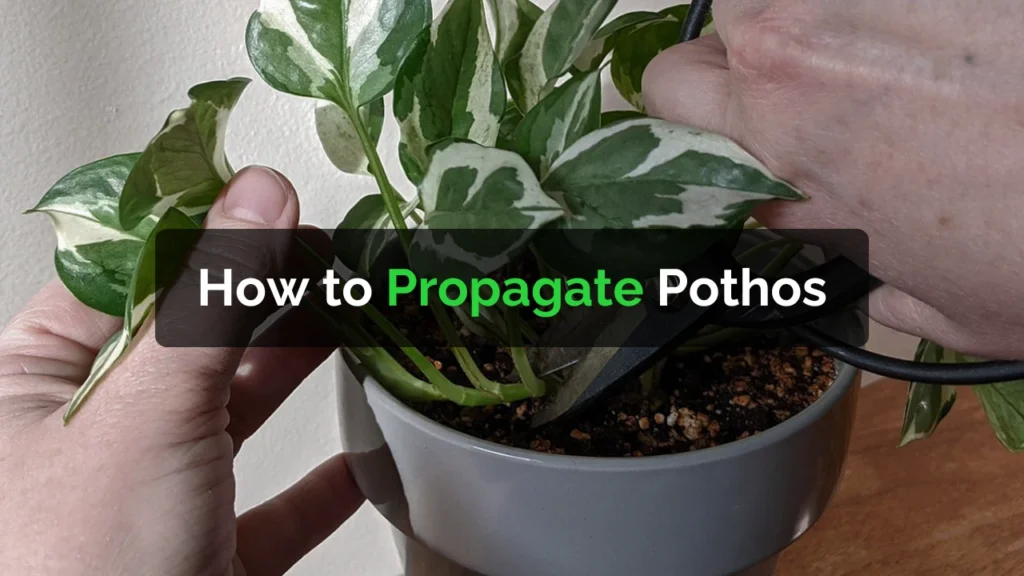Pothos is one of the easiest indoor plants to propagate, making it perfect for both beginners and experienced plant lovers. With just a few cuttings, you can grow new plants to decorate your home or share with friends. This guide explains step-by-step how to propagate pothos successfully in both water and soil.
Why Propagate Pothos?
Propagating pothos not only helps you grow more plants but also keeps your existing plant healthy. Regular propagation encourages fuller growth, prevents legginess, and gives you more vines to display in different corners of your home.
Best Time to Propagate Pothos
The best time to propagate pothos is during the spring and summer months when the plant is actively growing. Warm temperatures and bright light help the cuttings root faster and develop strong, healthy leaves.
Materials You Will Need
- A pair of clean, sharp scissors or pruning shears
- A healthy pothos vine
- A glass jar or small container
- Fresh water or potting soil
- Optional: rooting hormone (for faster root growth)
Step-by-Step Guide to Propagate Pothos in Water
1. Choose a Healthy Vine
Select a healthy vine with several leaves and visible nodes. Nodes are the small bumps or joints on the stem where roots will grow.
2. Make the Cut
Cut a 4–6 inch section of the vine, making sure the cutting has at least 3–4 leaves and one or two nodes. Trim the cutting just below a node.
3. Remove Lower Leaves
Remove the leaves closest to the bottom node so they do not rot in the water.
4. Place the Cutting in Water
Put the cutting in a glass of clean water, ensuring that at least one node is submerged. Place the jar in bright, indirect light.
5. Change the Water Regularly
Change the water every few days to keep it fresh and oxygenated. Roots will begin to form within 1–2 weeks.
6. Transfer to Soil
Once the roots are about 2 inches long, transplant the cutting into potting soil. Keep the soil slightly moist for the first few weeks until the plant adjusts.
How to Propagate Pothos in Soil
If you prefer to skip the water stage, you can propagate directly in soil.
1. Prepare a Small Pot
Fill a small pot with a well-draining potting mix. A mix designed for houseplants works well.
2. Dip in Rooting Hormone (Optional)
Dip the cut end of the stem in rooting hormone to encourage faster root growth.
3. Plant the Cutting
Insert the cutting into the soil, making sure the node is covered. Gently press the soil around the base to hold it in place.
4. Keep the Soil Moist
Water lightly and keep the soil evenly moist. Place the pot in a warm, bright spot away from direct sunlight.
5. Check for Growth
Within 3–4 weeks, you should see new leaves and roots forming. Once the plant establishes, care for it like a mature pothos.
Tips for Successful Pothos Propagation
- Use filtered or room-temperature water to prevent shock.
- Avoid placing cuttings in direct sunlight as it can damage tender roots.
- Keep humidity high around new cuttings for better growth.
- Always use clean tools to prevent infection or disease.
Common Problems During Propagation
- Yellowing Leaves: Usually caused by too much water or poor light.
- No Root Growth: Try changing the water more often or move the cutting to a brighter location.
- Rotting Stem: Make sure the node is not buried too deep or waterlogged.
FAQs
Can I propagate pothos from just one leaf?
No, you need at least one node for roots to grow. A single leaf without a node will not produce a new plant.
How long does it take for pothos to root?
In ideal conditions, roots start forming within 10–14 days. Full root development can take up to a month.
Is water or soil propagation better for pothos?
Both methods work well. Water propagation allows you to see root growth, while soil propagation helps plants adjust faster to their new environment.
Do pothos need sunlight to propagate?
Yes, but only indirect sunlight. Too much direct light can harm the cuttings.
Final Thoughts
Propagating pothos is a simple and satisfying process. Whether you choose water or soil, following the right steps ensures healthy new plants in no time. With proper care and patience, you can expand your indoor garden effortlessly and enjoy lush green vines throughout your space.





